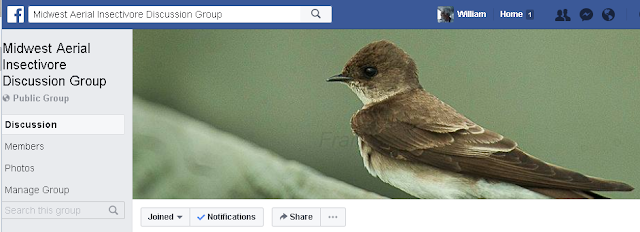This Discussion Group is on Facebook: https://www.facebook.com/groups/1581381955435390/
If you are interested in swallows, swifts, nightjars, flycatchers and their conservation - take a look!
By Wm. Mueller - - Ornithology, ecology, environmentalism, and our life in the natural world
Saturday, April 22, 2017
Friday, April 14, 2017
Bird conservation news - Partners In Flight
The Partners in Flight blog can be found at https://www.partnersinflight.org/blog/
One recent article there is particularly important: https://www.partnersinflight.org/scientists-document-widespread-declines-urgent-need-for-conservation-of-landbirds-in-u-s-and-canada/
Tuesday, April 4, 2017
Birds news around the world today
In case you'd like to read about some bird-related work, issues, news from various places around the globe:
BirdLife Cyprus news:
http://us12.campaign-archive1.com/?u=2d1fbb9f4f36d1c44c985f950&id=e42d7db64e&e=43f3c11825
Oriental Bird Club news:
http://orientalbirdclub.org/
The Norwegian Ornithological Society
http://www.birdlife.no/organisasjonen/english.php
BirdLife South Africa news:
http://www.birdlife.org.za/
How songbirds teach themselves songs:
https://www.sciencedaily.com/releases/2017/04/170404104719.htm
Pink-footed Goose - A bird likely to be increasingly found in eastern North America - Midwestern records coming in the next few years?
http://www.audubon.org/field-guide/bird/pink-footed-goose
BirdLife Cyprus news:
http://us12.campaign-archive1.com/?u=2d1fbb9f4f36d1c44c985f950&id=e42d7db64e&e=43f3c11825
Oriental Bird Club news:
http://orientalbirdclub.org/
The Norwegian Ornithological Society
http://www.birdlife.no/organisasjonen/english.php
BirdLife South Africa news:
http://www.birdlife.org.za/
How songbirds teach themselves songs:
https://www.sciencedaily.com/releases/2017/04/170404104719.htm
Pink-footed Goose - A bird likely to be increasingly found in eastern North America - Midwestern records coming in the next few years?
http://www.audubon.org/field-guide/bird/pink-footed-goose
 |
| Pink-footed Goose - ph. Wikim. Commons - Dave Dunford |
another obit for Chan Robbins
This is from the current (April 2017) Birding Community E-Bulletin, co-authored by Paul Baicich and Wayne Peterson:
CHANDLER ROBBINS: RIP
Sadly, the renowned ornithologist, author, educator, and
public servant, Chandler S. Robbins, passed away on 20 March. Chan, as
he was known to everyone, was 98 years old.
He graduated from Harvard with a degree in physics and began
teaching math and science in Vermont. Robbins joined the U.S. Fish and
Wildlife Service in 1945 as a junior biologist at Patuxent Research
Refuge in Maryland, where he engaged in early research on the effects of
DDT and had his papers edited by his USFWS colleague, Rachel Carson.
Also, Chan was the bander who first banded the Laysan Albatross named
Wisdom in 1956. He re-banded her, the world's oldest known banded bird,
in 2002. (See last month's E-bulletin for an update on Wisdom: http://tinyurl.com/E-bMar17 )
For many birders in the 1960s, their introduction to birding and to Robbins was through his role as lead author of A Guide to Field Identification: Birds of North America.
(See Book Notes above.) In 1966, this book - simply called "the Golden
Guide" by many - was a breakthrough field guide with profound features.
It covered all of the continental U.S. and Canada; all illustrations
were in color; birds were presented in a variety of postures and often
in some habitat; text and images were on facing pages; continental range
maps accompanied the text; measurements were of live birds, and those
puzzling sonograms were first introduced to an eager popular audience.
In the same year that the Golden Guide appeared, Chan
launched one of the most important citizen science tools that we have
today, the North American Breeding Bird Survey. The creation of the BBS
was not universally and instantly appreciated, however. He actually
received a disciplinary letter in his work file for its premature
launch!
In 1981, he co-authored the memorable paper familiar to an
entire generation of ecologists: "Effects of forest fragmentation on
avifauna of the eastern deciduous forest." This article led to a
national effort to identify and prioritize large, still-unbroken tracts
of forest while there was still time. In 2012, Chan declared that this
was the work of which he was most proud.
After his 60 years of full-time work as an avian biologist at
the USGS Patuxent Wildlife Research Center (he didn't retire until
2005), Chan became "Scientist Emeritus" at Patuxent where he actually
continued to work. One could often find him at his office at the far end
of the library, at the Gabrielson building, working on the next paper,
the next study, always keeping connected, and always making a
difference. Chan Robbins was at the same time a giant in the field of
bird study and also a gracious, quietly creative, and unassuming
colleague. The world has lost another of The Great Ones.
Subscribe to:
Comments (Atom)


